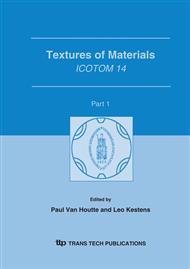p.1183
p.1189
p.1195
p.1201
p.1207
p.1213
p.1219
p.1225
p.1231
Simulation of Recrystallization Textures in fcc Materials Starting from Self-Consistent Modelling Results
Abstract:
Recrystallization (RX) textures in FCC materials have defied modelling for quite a long time despite the major micro-mechanisms influencing the texture development are currently considered understood. FCC materials are coarsely classified in high and low stacking fault energy materials with a rather continuous transition between them. Both extreme kinds will give rise, after rolling deformation and later RX, to what are called Cube and Brass texture patterns. Besides long discussions, not still settled, about the influence of twinning on deformation textures, attempts of simulating RX textures have been unsuccessful. The current contribution will show SelfConsistent (SC) plus RX modelling taking into account accumulated deformation energy and misorientation angles between neighbouring crystals. Starting from grains characterized by previous SelfConsistent simulations, nucleation is probabilistically allowed on each crystal whenever the accumulated energy is larger than certain threshold. Grain boundary mobility is commanded by a probability function of the misorientation angles also calculated by the SC model. The modelling is able to predict the right trend for many of the literature experimental data without resorting to other more sophisticated variables.
Info:
Periodical:
Pages:
1207-1212
Citation:
Online since:
September 2005
Authors:
Keywords:
Price:
Сopyright:
© 2005 Trans Tech Publications Ltd. All Rights Reserved
Share:
Citation:


